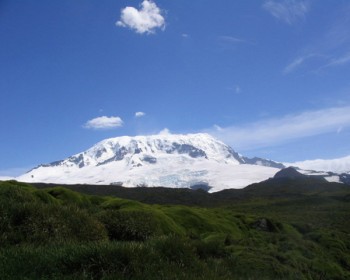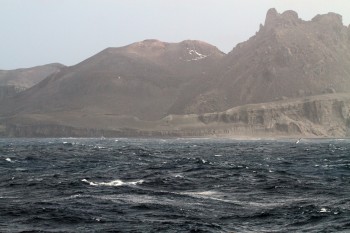The Australian Government has announced the expansion of the sub-Antarctic Heard Island and McDonald Islands Marine Reserve in the southern Indian Ocean by 6200 km², to 71 200 km² (click here).

Heard Island's central Big Ben and Mawson Peak
Photograph by Barbara Weinecke

A view of McDonald Island, photograph by Phil Moors
“Located 4,100 kilometres south-west of Perth, Heard Island and the McDonald Islands are home to truly unique flora and fauna that survive in a dynamic natural environment dominated by volcanic activity and glaciers. The original Reserve was declared in October 2002.
The Reserve’s boundaries were amended via Proclamation, with the Governor-General signing the Environment Protection and Biodiversity Conservation Amendment (Heard Island and McDonald Islands) Proclamation 2014 on 25 March 2014. The Australian Government’s decision to expand the Reserve follows a comprehensive scientific assessment of the region’s conservation values and extensive consultation with key stakeholders. This scientific assessment recommended that 6,200 square kilometres of ocean should be added to the Reserve on the basis that its waters are of high conservation value. These high conservation value waters possess outstanding and representative ecosystems, distinct benthic habitats and species, and foraging grounds for seabirds and mammals.
One of the most biologically pristine areas in the world, Heard Island and the McDonald Islands were inscribed on the UNESCO World Heritage list in December 1997 on the basis of their outstanding natural universal values.
Now possessing an area of 71,200 square kilometres, the Reserve is Australia’s largest IUCN 1a Strict Nature Reserve. IUCN Category 1a Strict Nature Reserves are designated to protect habitats, ecosystems and native species in an as undisturbed state as possible. Public access is primarily limited to scientific research and environmental monitoring. It is the highest level of protection afforded under the IUCN principles. The protection of these high conservation value waters within an IUCN Category 1a Strict Nature Reserve demonstrates the Australian Government’s commitment to the sustainable management of our great ocean resources.
The Reserve also includes the Commonwealth’s only active volcano. Rising 2745 metres above sea level, Mawson Peak is also the highest point outside of the Australian Antarctic Territory. Sporadic volcanic activity has been observed on Mawson Peak since 2012.”
View a map of the marine reserve showing its extensions here.
Selected Literature:
Australian Antarctic Division 2005. Heard Island and McDonald Islands Marine Reserve Management Plan. Kingston: Australian Antarctic Division. 198 pp.
Green, K & Woehler, E.J. (Eds) 2006. Heard Island Southern Ocean Sentinel. Chipping Norton: Surrey Beatty & Sons. 270 pp.
John Cooper, ACAP Information Officer, 03 April 2014

 English
English  Français
Français  Español
Español